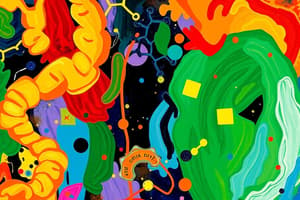Podcast
Questions and Answers
What are the two main categories into which amino acids can be classified?
What are the two main categories into which amino acids can be classified?
Essential amino acids and nonessential amino acids
Describe the process of protein synthesis briefly.
Describe the process of protein synthesis briefly.
The process involves transcription, where DNA provides the genetic code, and translation, where ribosomes read mRNA and attach amino acids according to codons.
What is the primary function of proteins?
What is the primary function of proteins?
To serve as enzymes, hormones, antibodies, structural components, and transport molecules.
How many standard amino acids are used by all known organisms?
How many standard amino acids are used by all known organisms?
What are proteins composed of?
What are proteins composed of?
What is the role of ribosomes in protein synthesis?
What is the role of ribosomes in protein synthesis?
What is the role of post-translational modifications in proteins?
What is the role of post-translational modifications in proteins?
How do proteases contribute to protein metabolism?
How do proteases contribute to protein metabolism?
What happens to the resulting amino acids after protein breakdown?
What happens to the resulting amino acids after protein breakdown?
How does understanding protein metabolism provide insight into organism function?
How does understanding protein metabolism provide insight into organism function?
Explain the importance of amino acid metabolism in the context of protein function.
Explain the importance of amino acid metabolism in the context of protein function.
What is the significance of the urea cycle in protein metabolism?
What is the significance of the urea cycle in protein metabolism?
Study Notes
Protein is one of the essential macronutrients required by all living organisms. It plays a critical role in various biological processes such as growth, repair, immunity, and muscle building. This article focuses on protein metabolism, specifically the process of amino acid metabolism.
Proteins are complex molecules composed of a chain of amino acids linked together through peptide bonds. These chains can fold into different three-dimensional structures depending on their specific sequence, which allows them to perform diverse functions within cells. The proteins' primary function is to serve as enzymes, hormones, antibodies, structural components, and transport molecules.
Amino acids are the building blocks of proteins, and there are 20 standard amino acids used by all known organisms. Amino acids can be classified into two main categories: essential amino acids and nonessential amino acids. Essential amino acids cannot be synthesized by the body and must be obtained from food sources. Nonessential amino acids can be produced by the body.
The process of protein synthesis involves several steps, which include translation, protein folding, and post-translational modifications. Proteins are synthesized through the process of transcription, where DNA provides the genetic code for making proteins. During translation, ribosomes read the genetic code of messenger RNA (mRNA) and attach amino acids according to the corresponding codons. The sequence of amino acids determines the specific structure of the protein.
Proteins can also undergo various post-translational modifications, such as phosphorylation, glycosylation, or ubiquitination, which can alter their function or subcellular localization. This allows for great diversity in the functional roles that these large molecules can play within the cell.
Proteins are also broken down and recycled through catabolic processes called proteolysis. There are numerous proteases, responsible for breaking down proteins into smaller peptides or individual amino acids for reuse. The resulting amino acids can enter the urea cycle, where they are converted to nitrogen waste products, including urea, that will eventually be excreted.
In summary, understanding protein metabolism, particularly amino acid metabolism, provides insight into how organisms maintain their structure and function while adapting to the environment. By exploring the interplay between protein production and breakdown, we can appreciate the importance of this ubiquitous macromolecule for life.
Studying That Suits You
Use AI to generate personalized quizzes and flashcards to suit your learning preferences.
Description
Test your knowledge on protein metabolism, amino acid synthesis, and the processes involved in protein synthesis, post-translational modifications, and proteolysis. Learn about the essential role of proteins as enzymes, antibodies, and structural components in living organisms.




